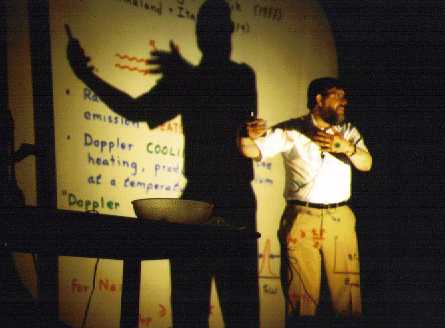

Dr. William Phillips in a dramatic pose,
explaining how Doppler cooling
can
cool atoms to less than a millionth of a degree of absolute
zero.
Now that's cold!
This year, the 54th ASA Annual Meeting was held at John Brown University in Siloam Springs, Arkansas to discuss issues of science and Christian faith. This year, for the first time in ASA history, the plenary speaker was a Nobel Laureate. William Phillips of the National Institute of Standards and Technology (formerly NBS) in Gaithersburg, Maryland, won the Nobel prize in 1997 for his contributions to low-temperature physics.
In his evening lecture, ìAlmost Absolute Zero: The Story of Laser Cooling and Trapping,î Dr. Phillips told of his work that unexpectedly won him the Nobel Prize. In a hot gas (such as the air outside the JBU auditorium), the atoms and molecules move more quickly than in a cooler gas. Using a variety of presentation media, including a demonstration in which balloons and flowers were cooled in a bucket of liquid nitrogen, which boils at 77 deg. Kelvin (where 0 Kelvin is absolute zero), or 320 deg. below zero Fahrenheit. Phillips conveyed the notion that the world of low temperatures is strange. In his affable and good-natured style of delivery, Phillips continued to present his talk as he blew up and tied balloons, inserting them into the liquid nitrogen bucket, which appeared to be able to hold only about two balloons. After inserting a half dozen of them, the audience could not help but wonder where they were going!
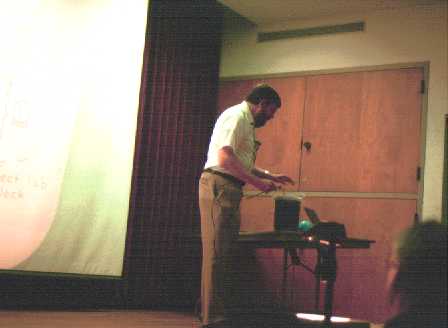
As he pulled them out later with tongs, he showed that the air in the balloons had liquified due to cooling and the balloons had collapsed. (In fact, this demonstrates the meaning of absolute zero: the temperature at which a volume of ideal gas shrinks to zero volume.)
Dr. Phillips' work was motivated by a seemingly unrelated interest, the desire at the nationís standards lab to make more accurate atomic clocks for measuring time. Spinning atoms have their own precise resonance frequencies that can be used as a time standard. The identical atoms of a given element form a beam emitted from a source, where the local laboratory clock is synchronized to them. They continue to travel a meter or so in several milliseconds, and their timing is then compared to the lab clock. Any discrepancy in timing between the beam of atoms and the lab clock is used to adjust the lab clock. Accuracies on the order of one part in 100 trillion (10-14) can be achieved. Such clocks have many practical applications, such as in the Global Positioning System and as frequency references for the electronics industry.
"But we are greedy", Phillips said, "and we want better accuracy." More transit time is needed for the beam of atoms. The travel distance could be increased before the clocks are compared, but complications such as gravity and unwieldy equipment size make this approach impractical. However, if the atomic stream could be made to travel more slowly instead, there would be more time between synchronization and comparison. This led to the search for methods of slowing streams of atoms. Dr. Phillipsí presentation, well-suited for both a popular and general technical audience, proceeded to laser cooling.
It is known that atoms of a particular element, such as cesium, have a set of "hyperfine" resonance frequencies due to interactions among the atom's electrons and its nucleus. Atoms are thousands of times smaller than light waves, and most frequencies of light shine right through them, but near a resonance frequency an atom can absorb light and experience a force from it. Furthermore, when atoms move, they ìseeî light shifted in frequency due to the Doppler effect, the same effect that makes the high-pitched whine of an oncoming car shift to a lower tone as it passes. The same effect happens with light; an atom moving towards a light beam will "seeî the color of the beam shifted toward the blue or higher-frequency end of the spectrum.
So Dr. Phillips' team exploited these known features of atoms. By using a laser with a light frequency (or color) slightly below one of an atomís resonance frequencies, movement of the atom toward the beam will Doppler-shift the color the atom sees up to the frequency where the atom will ìfeelî the force of the beam. With a 3-dimensional arrangement of lasers, atoms can be trapped by multiple laser beams, creating what is called "optical molasses".
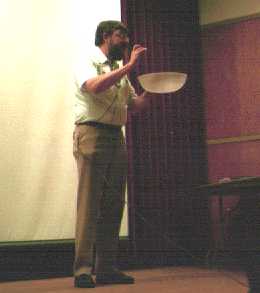
Phillips shows how atoms trapped in "optical molasses" are like a ball trapped in a bowl.
While other scientists had been working on laser cooling, Phillipsí group measured the temperature of trapped atoms as six times lower than the value predicted from theory, even though it was already a tiny fraction of a degree from absolute zero. ìWe were astounded!!î flashed the viewgraph. He said it is unusual for experiments to work out better than theory, violating Murphyís Law. The better-than-possible results of 40 microdegrees K were at first questioned. But the other two recipients of the Prize worked out an explanation (ìSisyphus coolingî). Dr. Phillips explained in ìA Brief History of Temperatureî that a phenomenon predicted by Einstein - atoms with integer spin(called bosons) can be cooled to the point where they all fall into the same lowest energy state (Bose-Einstein condensation) -- has been achieved at a record low temperature to 10 nanodegree K (10 billionths degree above absolute zero), with plans for experiments in space to reach 1 picodegree K (one-trillionth degree). Now that's really cold! (Just recently, colleagues of Phillips have detected a counterpart to Bose-Einstein condensate for half-integer spin atoms, or fermions, at 0.6 microdegrees).Back to atomic clocks: with all the success of laser cooling, now atoms can be made to move so slowly, they fall under gravity and the original atomic-clock scheme does not work. Instead of a horizontal beam between clock source and comparison point, the atoms are instead shot up vertically like a fountain, and compared when they come down. This allows the "hang time" to become as long as one second, which permits 1 or 2 orders-of-magnitude improvement in time standards to be developed.
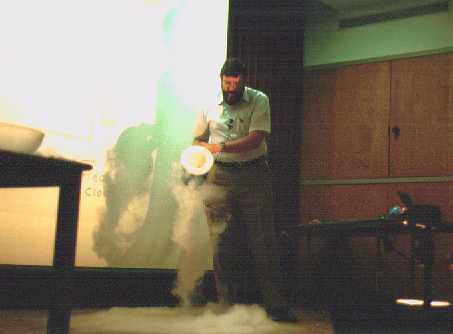
At the end of his
lecture, Phillips pours liquid nitrogen on the floor.
It boils instantly, the
floor being 320 degrees F. hotter than the liquid.
After winning the Nobel Prize, Dr. Phillips mentioned God in response before the mainstream media press. This labeled him as the ìreligious Nobelist,î and led to subsequent press inquiry. Phillips showed video clips of additional comments he had made on Swedish and Brazilian television, and in his second talk on receiving the Prize as a Christian, he credited a book well-known in ASA circles, The Fourth Day, by Dr. Howard Van Till, an astronomy professor at Calvin College in Grand Rapids, Michigan. It so happened that one of Phillips' students was teaching at Calvin College, which brought Dr. Phillips to the campus a week before before receiving the prize announcement. While there, he obtained copies of Van Tillís book. This book led Phillips to think about the relationship of science to Christian faith, which he said helped to prepare him to discuss his beliefs before the public.
Dr. Phillips showed some video clips of people at his church in Maryland, a multiracial church in which he sometimes teaches and sings in the choir. Several other physicists are members too. He also showed video clips of the Nobel ceremony, with its Swedish royalty and formal protocol. The clip shows, with humorous comment from Phillips, the three physics recipients nervously not knowing what to do with their hands. Phillips blew his wife a kiss after bowing to the Swedish audience when he received the prize, which the queen of Sweden told him she thought was sweet. But ìThis was considered enough of a breach of protocol that it was in the papers the next day,î Phillips said, grinning, as the ASA audience roared. Phillips told of one of the many letters he had received after winning the Prize. One that stuck with him was from the daughter of a former Nobel laureate. She related how her father told her that she meant more to him than the prize, and Phillips emphasized that the love of family and friends mean more than the trappings of professional life.
Dr. Phillips explained to the Swedish television audience that he does not see a conflict between science and Christianity. Religion tells us how to relate to each other and science shows us how God constructed the universe. Phillips acknowledged his responses as reflecting his quick study of Van Tillís book, which, he said, helped to organize his thinking about their relationship.
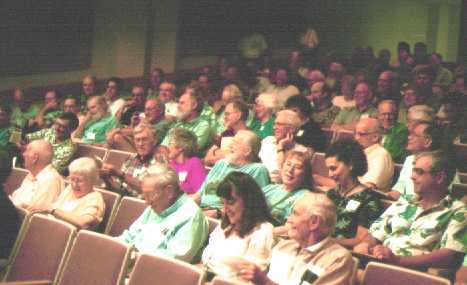
The audience is delighted to see and hear Dr. Phillips and his dramatic demonstrations of low-temperature physics.
On another occasion, Phillips was invited to a White House event that Stephen Hawking also was attending. At first Phillips turned it down because he had a schedule conflict with his doctor that took a long time to set up. But the White House called him again, and he then realized that he doesnít get too many invitations from the White House, so he reconsidered and rescheduled the medical appointment. The video clip shows the Clintons, Hawking, and Phillips nearby, answering the question: ìWhy does the universe obey any laws at all?î Phillips referred to fine-tuning and anthropic ideas before offering a theological response, which he said, did not differ that much from them. Francis Collins, head of the Human Genome Project and also a Christian, was at the same event. When Dr. Varmus, head of NIH, observed Phillips and Francis talking with each other, he mused that he was not surprised to see ìyou God guysî conversing.
Dr. Phillips also talked about the ethics of doing science. When a competing team failed to cite his groupís work in their paper, one of Phillips' students suggested they do the same. But Bill Phillips said: thatís not what we will do; we will highlight their work in our paper. He emphasized the importance of setting a good example among fellow scientists.
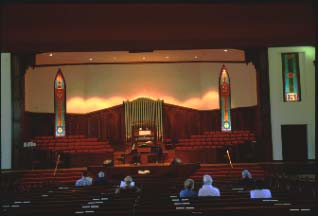
Interior of the Chapel of the Ozarks at John Brown University, site of the ASA meeting
For more information about Phillips' research in laser cooling, please see the following web sites:
http://www.nobel.se/announcement-97/physics97.html
http://physics.nist.gov/News/Nobel/1997nobel.html
http://physics.nist.gov/News/Releases/n96-02.html
http://www.aip.org/pt/articles/90/100207/index.html